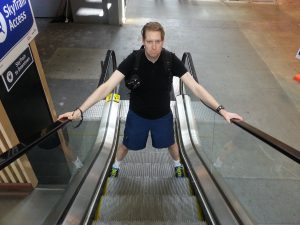In the interest of full disclosure—and Seth-promotion—the spirt of this rant, and other works of Sethiquette, is now available in my book, How to Cure Yourself of Narcissism.

Anyone who’s had the good fortune to share an escalator with me is likely familiar with this rant: and so, for their nostalgia and everyone else’s first-time enjoyment, I would like to officially announce:
I reverse-heart escalator-standers.
Why would a healthy individual interrupt their day (in which, I’m told, time is precious) to wait for a slow machine to carry them to their destination, when the device offers the option to move at double its speed by simply walking?
Note of rant sanctuary: If an escalator-stander has a health condition (sore knees, sore heart, maybe escatripaphobia), or is simply tired and not in the mood to climb moving stairs, they are excused from the ire of this rant.
Note of excommunication from rant sanctuary: The tired stander will be returned to the rant’s scope, however, if they are one of a pair of standers, who—instead of standing one after the other to allow safe passage of those behind—block both lanes of escalator travel so that those who would prefer to kill calories (instead of time) cannot proceed.
My primary objection is to those who stand because of what I can only surmise is habit: I watch 20 year-olds arrive at the escalator and, without apparently pausing to ask, “Do we feel like adding a tiny bit of exercise to our diet?” they stop and stare ahead. I suppose they could have a good reason for the slow-down: maybe it’s their first time on an escalator, and so they want to savour the experience; or perhaps they’re trying to conserve calories: why waste energy that they could store for later?
But I think the most reasonable explanation for why most people stop on an escalator without considering walking is that they are in some sort of trance, a temporary off-button that has suddenly made time not matter to them.
I spend most of my escalator time en route to catching Skytrains, which arrive approximately every five minutes, and so, if I’m forced to I slow down just enough (often because of an escalator-standing-blockade), I often narrowly miss a just-arriving train, thus causing me to get to my destination five minutes later. It’s rare that my hope is to be five minutes later for anything. Yes, Alabama, I realize that we shouldn’t “rush and rush until life’s no fun,” but, if it’s easy, and you happen to be in a hurry, why not step up?
For instance, I’m convinced that the people standing on the escalator to go to the movies would like to get into the ticket-buying lineup as soon as possible to secure goods seats, and yet—with knees capable of speedily climbing to the back of the theatre—they inexplicably freeze the moment their feet hit the escalator.
Indeed, I have been late with friends to a movie, and have felt the “Kumbaya” of our mutual rush only to arrive at an escalator to witness the sudden suspension of my companions’ movement as though the matter is out of their feet’s hands: the escalator, after all, speeds up for no one—what are they supposed to do?
This behaviour seems so irrational to me that I must find a cause to blame. Perhaps it is the fault of our oft-described “sedentary” modern western society and our tendency to avoid unnecessary movement? But I suspect something more sinister: I suspect it is our brains that are sedentary, and that it simply doesn’t occur to people to keep moving on a machine that will get them there eventually.
Evidence for this hypothesis can be found in the aforemocked people who stand two-by-two on the escalator such that they become a obstruction for any would-be non-lazy-people behind them. Surely, if it even occurred to them that someone might like to get by, they wouldn’t be so selfish as to stand in the way, would they?
If I’m right that people stand on escalators because they never thought to use the steps for climbing, then I have replaced one baffling question with another: why the heck wouldn’t it occur to them? I can understand the inclination to let the vehicle do all the moving in the case of cars or buses, but to stop, without thinking, on a device that offers you the option of safely doubling your speed of travel is, to me, a kin to riding one’s bike and discovering a slight decline and so deciding to stop pedaling so as to allow gravity to do all the work for you. If you’re tired, or in the mood to relax and look around, then you have my warmest blessings, but if you stop your exercise simply because you see no point in doing otherwise then I don’t get it.
Similarly, I guess if the sun’s bugging your eyes, then there’s no need to walk to a shadier spot: after all, the earth will eventually transport you out of the sun’s gaze. So, yeah, just sit there and wait.
All poignant exaggeration-sarcasm aside, clearly escaltor-standing is a mystery that I’m not able to solve here, but, if you are a career escalator-stander with no health reasons to justify this habit, I’d like to make a tiny suggestion: try escalator-walking just once. You may be surprised to discover that motorized-inclines aren’t as daunting as they look from the bottom.
If, however, you still see no point in walk-riding when you could just ride, I request that you at least not stand in the way of those who would choose to stroll freely. Stay in your lane, and nobody gets glared at on my way by.

P.S. If I were artistically inclined, I would create a cartoon of a couple standing on an escalator with no one in front of them, a crowd behind them, and a thought bubble above them that simply states, “Where does all the time go?”
P.P.S. Even brillianter, I refer you below to Becel’s heart health commercial, the most profound advert in television history. It deals with the mystery of the escalator stander with grace and impeccable honesty.

Seth, I think the problem is that the current generation has not grown up watching the Flinstones. You see, in the Flinstones, as per your observation re. transportation assistance, the characters had to drive their cars by walking them. Thus, we as viewers were conditioned to MOVE while being transported by things. This has been further worsened for our subsequent generations by such delightful toys as “PowerWheels”, because, as we know from the late 80s/early 90s ads, “PowerWheels power makes it go”– i.e. not our power. So, therefore, we have trained an entire legion of people who really don’t get the most basic tenet of transportation… it’s all a big illusion and really everything is just human powered.
Of course, this theory breaks down in a few, very small places (not the least of which is the fact that us “old timers” don’t hang our legs out of busses/cars and try to run along beside), but I leave the rest as an exercise to the reader.
-k.
Thank you, Kim. You make a brilliant point: I was rather hasty in my assumption that, in the case of cars (unlike escalators), one would not be expected to walk in order to speed the vehicle up. I had forgotten about our foreFlinstones who did just that.
Perhaps, as you suggest, if more people witnessed the transportation efforts of those characters, they would be willing to put in a little of their own energy for more efficient escalator travel.
Why don’t people walk on escalators?
The same reason people don’t jump in elevators, or push forward on their steering wheels, of course.
Thank you “Escalator-stander” for standing up for the other side. In fact, I’m Seth McDonough and I approve your comparison: after all, it’s the same one I used in my rant. (Except, in my case, I teased that, whereas in cars there would be no advantage to continuing to move forward on one’s own, on an escalator, you can double your pace by moving your legs. As you suggest, pushing on a steering wheel, or jumping on escalator, offers no such advantage.)
The reason I stand on an escalator is because its difficult to continue a decent conversation while huffing & puffing as you climb the steeper than normal steps on an escaltor.
Dear Sethblogs,
One morning as I approached the Skytrain station, I braced myself for the inevitable escalator-standers. To my delight, from afar, it appeared as though everyone was choosing to walk on the device. As I expectantly mounted the revolving stair machine myself, primed to rush up in order to catch the next train, which I could hear approaching at that very moment, my hopes were frustrated because of a phenomenon related to, and, I will argue, almost as exasperating as, the escalator stander. I hereby present Exhibit B: The Escalator Slow Walker. Most people, especially in the morning on their way to work, walk at a fairly steady clip, as I myself was. When these people reach the escalator, however, their brisk jaunt inexplicably turns into a slow, one-step-at-a-time plodding. As I had no choice but to regulate my speed to that of the governing mob, I plodded along with them, having time to observe that, even though we escalator users had the help of a machine, the people adjacent to us on the old-fashioned stairs were still able to beat us to the top with plenty of time to spare because they ascended the steps at a regular, slightly rushed pace befitting to the rush-hour, impendig train situation. I would argue that escalator slow-walkers are just as bad as escalator standers, because the former group is a maddeningly deceptive strain of those who choose to shut off their brains and normal motoric functions when on an escalator. Thoughts?
Fair enough, Social Butterfly: if indeed one has a reason to stand on the escalator (as you do) then I have no moral objection to the practice. My quibble is with those who seem to do it (A) without thinking and (B) without allowing space for those behind who may not share the same lack of rush.
To this end, I must congratulate commenter, Natalie, for her work in unearthing the sequel villain, “The Escalator Slow Walker”. I find your description of the “governing mob” (that sometimes slows the pace of movement on moving stairs more even than on regular stairs) both elegant and poignant. Although, in general, I have found “slow-walkers” to be an inconsiderate lot wherever they choose to plod. Who among us with reasonably-paced feet has not been caught behind a slow walker who takes up the middle of the sidewalk, staircase or aisle such that they leave just not enough room to pass on either side of them?
To take the edge off this painful experience, let us call upon Mr. Bean to demonstrate the general frustration (without necessarily a villain in this case)…